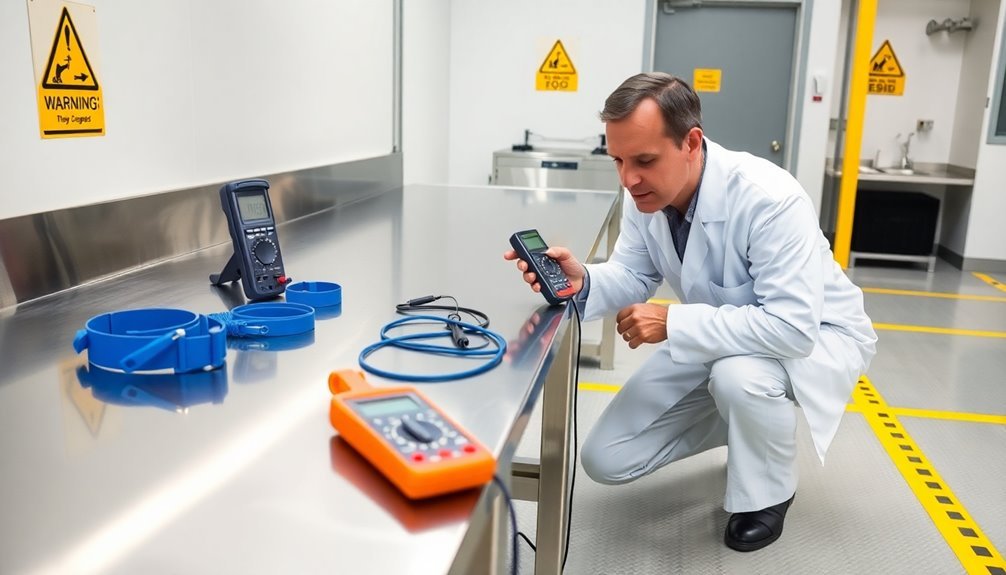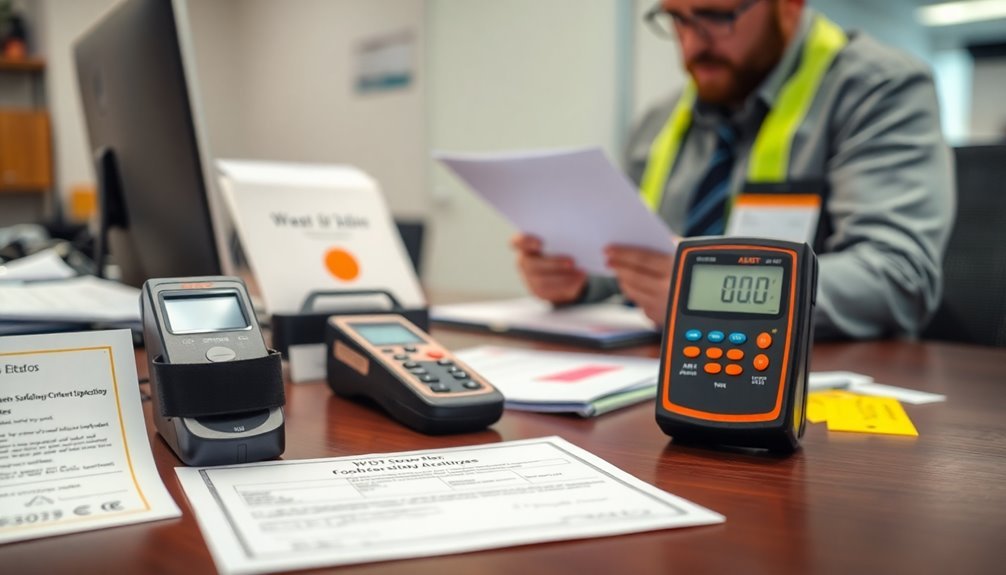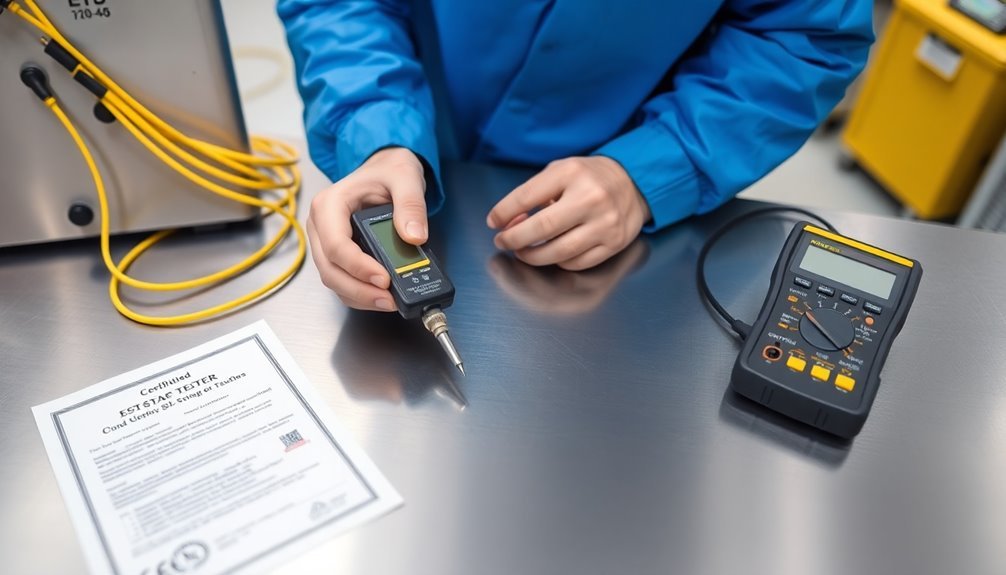To achieve ESD monitoring system certification success, you'll need to follow three critical steps. Start by establishing a thorough ESD control program that identifies susceptible items and defines protected areas with clear boundaries. Next, prepare your EPA testing requirements by implementing standardized protocols and setting control limits for equipment, surfaces, and personnel. Finally, document your certification audit process through detailed checklists, regular verification audits, and proper record-keeping of all findings. Following these steps while staying current with industry standards like ANSI/ESD S20.20-2014 will set you on the path to maintaining effective ESD protection that safeguards your sensitive electronics.
Establish Your ESD Control Program

Through careful planning and implementation, establishing an effective ESD Control Program requires a systematic approach to protect sensitive electronic components.
You'll need to begin by identifying ESD susceptible items through thorough risk assessment and understanding device sensitivities. This foundational step guarantees you're protecting the right components with appropriate measures. Staying current with industry standards like ANSI/ESD S20.20-2014 is essential for proper component protection.
Next, you'll define your ESD Protected Area (EPA) by clearly marking boundaries with floor tape, signs, and implementing access control devices. Within this area, you must select and install appropriate ESD control items, including specialized worksurfaces, flooring, seating, and ionization equipment that match your manufacturing process requirements.
Your program won't succeed without proper training, so develop a thorough plan that covers both initial and recurring ESD awareness sessions for all personnel handling sensitive items.
You'll need to document everything in your ESD Control Program Plan, including specific procedures, qualified products lists, and compliance verification methods. Make sure you've secured management support and appointed an ESD coordinator to oversee the program.
Regular compliance verification through periodic checks and calibration of test equipment will guarantee your program maintains its effectiveness over time.
Prepare EPA Testing Requirements
Preparing your EPA testing requirements demands a systematic approach to guarantee extensive protection of sensitive electronic components. You'll need to start by identifying all equipment that requires regular testing and establishing clear methodologies for each item within your EPA. Ionization systems require consistent verification to neutralize static charges effectively.
When specifying your testing methods, you'll want to prioritize contact discharge testing, though air discharge becomes necessary when contact isn't feasible. Make sure you're following standardized testing protocols like IEC 61000-4-2 for commercial applications, and document any justified deviations from these standards.
You'll need to determine and document specific testing frequencies for all EPA items, ensuring you've assigned qualified personnel to carry out these verifications. It's essential to maintain detailed records that demonstrate your conformity to technical requirements.
Set clear control limits for your equipment, particularly noting that resistance to ground must be less than 1 × 10^9 Ω for EPA flooring. Your testing program should specify appropriate limits for both contact and air discharge methods.
Remember to align all control limits with your compliance verification plan and relevant industry standards to guarantee thorough ESD protection.
Document Certification Audit Process

Documenting your certification audit process requires meticulous attention to detail and a structured approach to guarantee completeness.
You'll need to start by clearly defining your audit objectives and establishing the scope of your assessment, including all areas, processes, and equipment that require ESD monitoring certification.
During the documentation phase, you'll want to create a thorough audit plan that outlines your timeline, required resources, and team composition.
Make sure you've gathered all relevant documentation, including industry standards, procedures, and any previous audit reports. Regular verification audits should be conducted at least six times annually to maintain certification standards.
You'll need to develop detailed checklists to guide your assessment process.
As you conduct the audit, document all your findings meticulously.
Record any non-conformities you discover, classify them by severity, and note their potential impact on ESD risks.
Don't forget to collect supporting evidence through measurements, photographs, and detailed observations.
Finally, compile your findings into a structured certification audit report.
Include all identified risks, non-conformities, and your recommended corrective actions.
You'll want to establish a clear timeline for implementing improvements and schedule follow-up audits to verify ongoing compliance with ESD control measures.
Frequently Asked Questions
What Happens if We Fail the Initial Certification Audit?
You'll face financial penalties, operational disruptions, and potential contract losses. You'll need to address identified issues, implement corrective actions, and schedule a re-audit to maintain your business relationships and certification status.
Can Multiple Facilities Share a Single ESD Certification?
No, you can't share a single ESD certification across multiple facilities. Each location must undergo its own separate audit and certification process to guarantee compliance with ANSI/ESD S20.20 or IEC 61340-5-1 standards.
How Much Does ESD Certification Typically Cost?
You'll typically pay $1,950 per person for ESD Program Associate Certification, plus annual renewal fees. Your total cost will vary based on your organization's size and needs for certification audits.
Are Temporary Workers Required to Complete the Same ESD Training?
Yes, you'll need to complete the same initial ESD training as permanent staff before handling sensitive devices. Your training must cover fundamentals, equipment use, and safety procedures according to ANSI/ESD S20.20 standards.
Can We Transfer Our ESD Certification When Relocating Facilities?
No, you can't transfer your ESD certification when relocating. You'll need to undergo a complete new audit at your new facility location since certifications are facility-specific and require site-specific compliance verification.
In Summary
You've now got the key steps to achieve ESD monitoring system certification. By establishing your control program, preparing EPA testing protocols, and documenting your certification audit process, you're well-equipped to protect sensitive components and meet industry standards. Don't forget to regularly review and update your procedures – it's essential for maintaining certification and ensuring long-term ESD protection success.





Leave a Reply